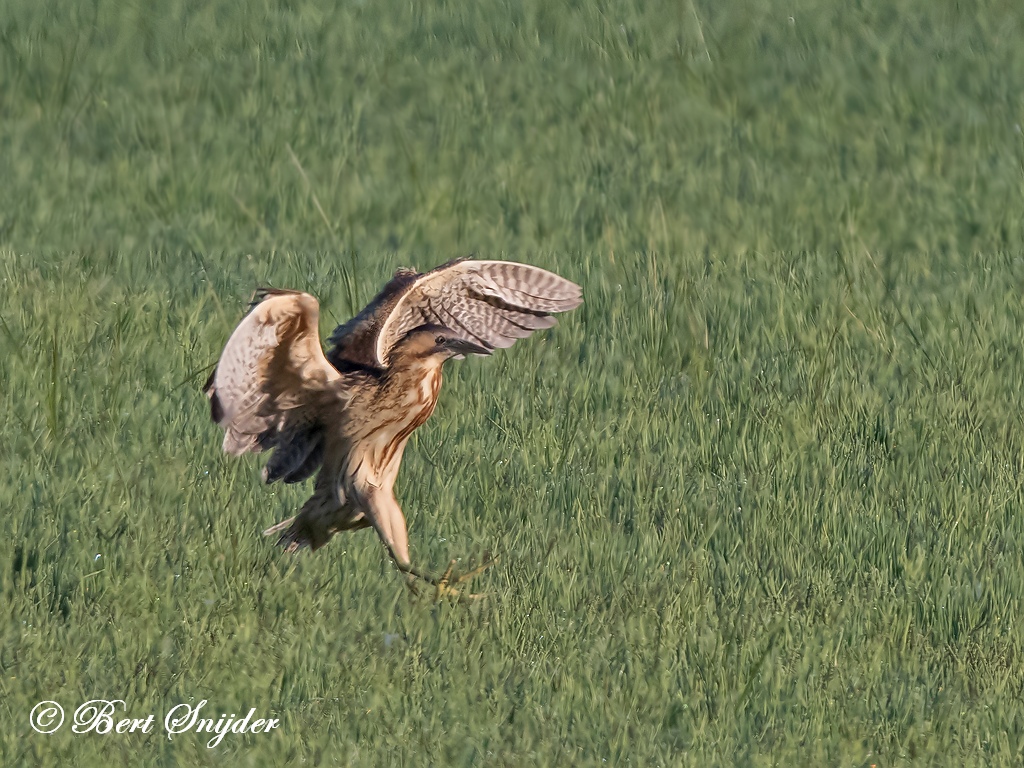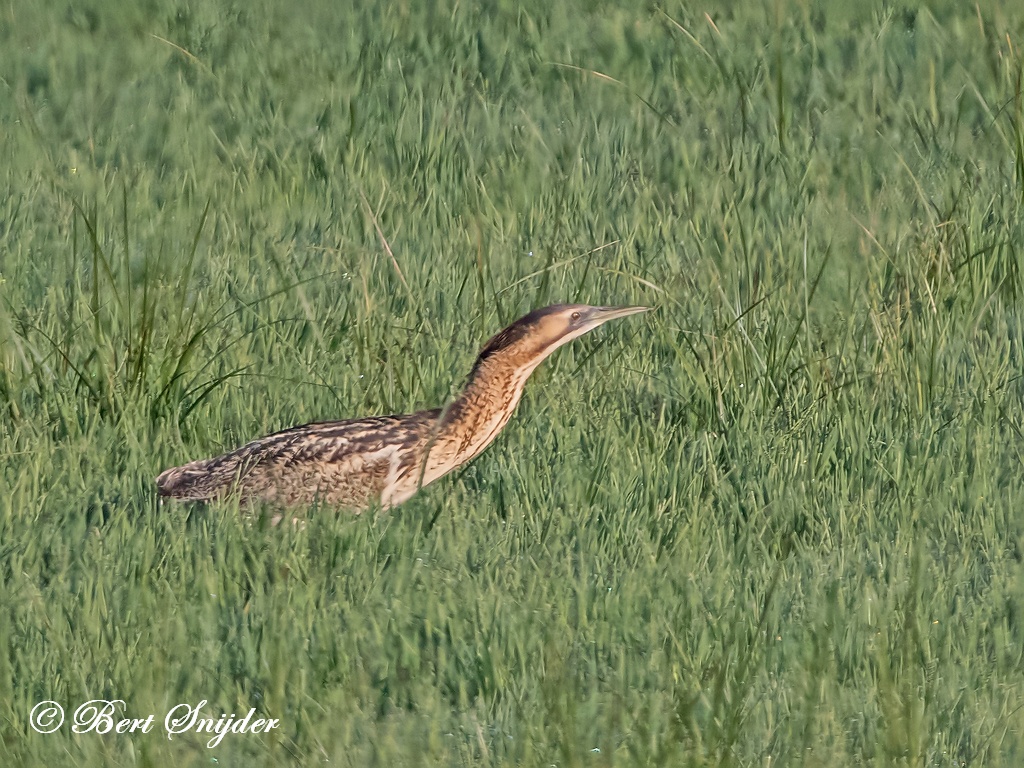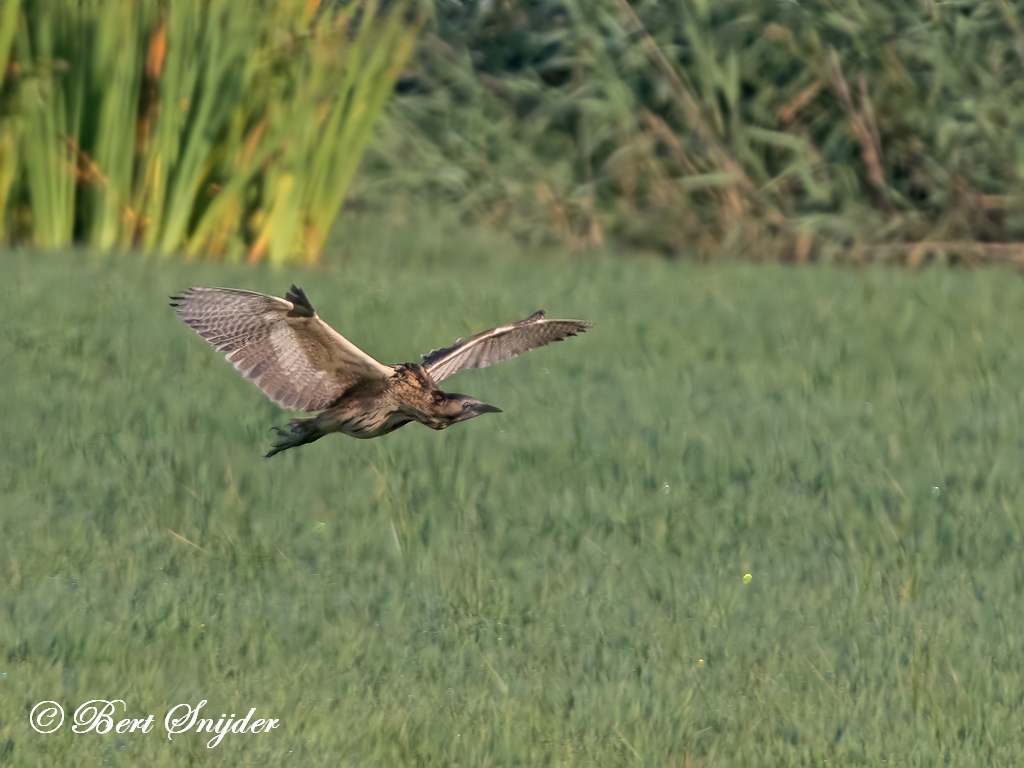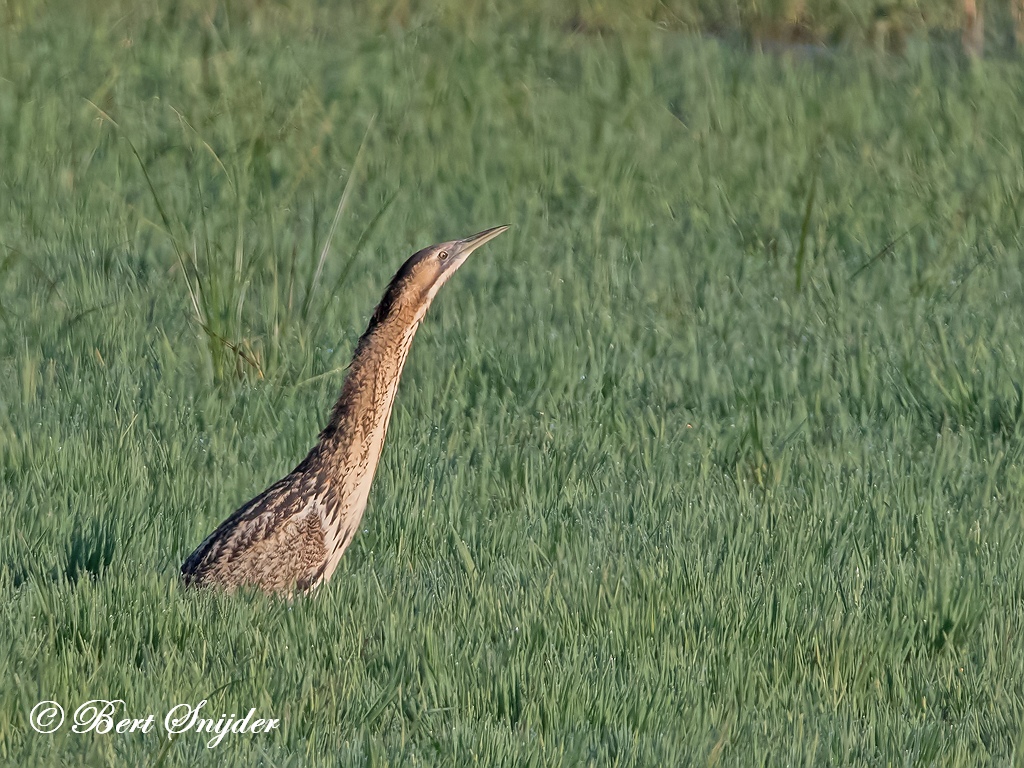Spotted in the Alentejo region of Portugal. Great Bittern sound
The Eurasian Bittern or Great Bittern (Botaurus stellaris) is a wading bird in the bittern subfamily (Botaurinae) of the heron family Ardeidae.

More photos at the bottom of the page.
There are two subspecies, the northern race (B. s. stellaris) breeding in parts of Europe and Asia, as well as on the northern coast of Africa, while the southern race (B. s. capensis) is endemic to parts of southern Africa.
It is a secretive bird, seldom seen in the open as it prefers to skulk in reed beds and thick vegetation near water bodies. Its presence is apparent in the spring, when the booming call of the male during the breeding season can be heard. It feeds on fish, small mammals, fledgling birds, amphibians, crustaceans and insects.
The nest is usually built among reeds at the edge of bodies of water. The female incubates the clutch of eggs and feeds the young chicks, which leave the nest when about two weeks old. She continues to care for them until they are fully fledged some six weeks later.
With its specific habitat requirements and the general reduction in wetlands across its range, the population is thought to be in decline globally. However the decline is slow, and the International Union for Conservation of Nature has assessed its overall conservation status as being of “least concern”. Nevertheless, some local populations are at risk and the population of the southern race has declined more dramatically and is cause for concern. In the United Kingdom it is one of the most threatened of all bird species
Bitterns are thickset herons with bright, pale, buffy-brown plumage covered with dark streaks and bars As its alternate name suggests, this species is the largest of the bitterns, with males being rather larger than females. The Eurasian or Great Bittern is 69–81 cm (27–32 in) in length, with a 100–130 cm (39–51 in) wingspan and a body mass of 0.87–1.94 kg (1.9–4.3 lb).
The crown and nape are black, with the individual feathers rather long and loosely arranged, tipped with buff narrowly barred with black. The sides of the head and neck are a more uniform tawny-buff, irregularly barred with black. The mantle, scapulars and back are of a similar colour but are more heavily barred, the individual feathers having black centres and barring. The head has a yellowish-buff superciliary stripe and a brownish-black moustachial stripe. The sides of the neck are a rusty-brown with faint barring. The chin and throat are buff, the central feathers on the throat having longitudinal stripes of rusty-brown. The breast and belly are yellowish-buff, with broad stripes of brown at the side and narrow stripes in the centre. The tail is rusty-buff with black streaks in the centre and black mottling near the edge. The wings are pale rusty-brown irregularly barred, streaked and mottled with black. The plumage has a loose texture, and elongated feathers on the crown, neck and breast can be erected. The powerful bill is greenish-yellow with a darker tip to the upper mandible. The eye has a yellow iris and is surrounded by a ring of greenish or bluish bare skin. The legs and feet are greenish, with some yellow on the tarsal joint and yellow soles to the feet. Juveniles have similar plumage to adults but are somewhat paler with less distinct markings.



Other synonyms:
Afrikaans: Grootrietreier, Grootrietreier (Roerdomp)
Arabic: الواق, الواق بو الخصيف, بوبو(الواق الكبير)
Asturian: Avetoru, Garcia Muxidora
Azerbaijani: Iri danquşu
Belarusian: Бугай, Чапля-бугай
Bulgarian: Голям воден бик
Bengali: বাঘা বগলা
Breton: Ar bongorz bras, Bongorz
Catalan: Bitó, Bitó comú, Bitor
Catalan (Balears): Bitó
Valencian: Bitor
Montenegrin: bukavac
Czech: Bukac velký, Bukač velký, bukaè velký
Welsh: Aderyn y bwn, Bwm y gors, Bwmp y gors
Danish: Rørdrum
German: Große Rohrdommel, Rohrdommel, Rohrdrommel
Greek: (Ευρασιατικός) Ήταυρος, Βουρωδιός, Ηταυρος
Greek (Cypriot): Βουρωδιός
English: African Bittern, Bittern, Common Bittern, Eurasian Bittern, Eurasian Great Bittern, Great Bittern, Pinnated Bittern
English (IOC): Eurasian Bittern
Esperanto: Granda botaûro
Spanish: Avetor Comun, Avetoro, Avetoro Común, Mirasol Común
Spanish (Spain): Avetoro Común
Spanish (HBW): Avetoro común
Estonian: Hüüp
Basque: Bitó comú, Txori zezen arrunt, Txori zezen arrunta
Persian: بوتیمار بزرگ
Finnish: Kaulushaikara
Faroese: Mækjuglámur
French: Butor d’Europe, Butor étoilé, Grand Butor
Frisian: Reiddomp
Irish: Bonnán
Gaelic: Corra Ghrain
Galician: Abetouro, abetouro común, Bitó comú
Manx: Coar vooar
Hebrew: אנפה מסורטטת, אנפה משורטטת
Croatian: Bukavac, Bukavac nebogled
Hungarian: Bölömbika
Armenian: [Mets Jrntsul ], Մեծ Ջրցուլ
Icelandic: Sefþvari
Italian: Tarabusco, Tarabuso, Tarabuso eurasiatico
Japanese: sanka no goi, sankanogoi, Sankano-goi
Japanese: サンカノゴイ
Japanese (Kanji): 三家五位
Georgian: დიდი ყარაულა, ყარაულა, წულის ბუღა, წყლის ბუღა
Khakas: Кöл пугазы
Kazakh: Үлкен кєлбұқа, Үлкен әупілдек
Kazakh (Transliteration): ülken kölbuqa
Korean: 알락해오라기
Korean (Transliteration): allak-haeoragi, odoi tsoiron, turag bukh shuvuu, usni bukh
Karelian: Kaglushaikar
Cornish: Clabyttour
Kwangali: Shivo
Scientific: Ardea stellaris, Botaurus stellaris, Botaurus stellaris stellaris
Luxembourgish: Grouss Dommel, Mouerochs
Lithuanian: Bublys, Bukas, Didysis baublys, Dūkas, Kaukutis, Rėklys, Ūpas
Latvian: Dumplis, Ezergailis, Lielais dumpis, Ūdens vērsis
Macedonian: Букаец, Голем воден бик
Malayalam: പെരുങ്കൊച്ച
Mongolian: Бух шувуу, Тураг бух шувуу, Усны бух, Усны бухшувуу
Mongolian (Bichig): ᠣᠰᠣᠨ ᠤ ᠪᠣᠬᠠ ᠰᠢᠪᠠᠭᠣ
Mongolian (Bichig, Inner Mongolia): ᠣᠰᠣᠨ ᠤ ᠪᠣᠬᠠ
Mongolian (Cyrillic, Inner Mongolia): Одой цойрон, Усны бух шувуу
Mongolian (Transliteration): usni bukh-shuvuu
Moldavian: Buhai de baltă
Malay: Burung Pucung Danau, Burung Pucung Paya
Maltese: Kappun
Dutch: Roerdomp
Norwegian Nynorsk: Røyrdrum
Norwegian: Rørdrum
Polish: bak, Bąk, bąk (zwyczajny), Bąk przylądkowy, Bąk zwyczajny
Pinyin: dà má-lù, dà má-yán, dà shuǐ luòtuo, pú jī
Portuguese: abetouro, Abetouro-comum
Portuguese (Portugal): Abetouro
Romansh: Tarbegl grond
Romanian: Buhai de baltă
Russian: Vyp, Большая выль, Большая выпь, Выпь, Выпь большая
Scots: Corra ghrain
Sindhi: ث رًډ يب ث ٿٍِ
Slovak: Bučiak trsťový, bučiak trsťový/bučiak veľký, Bučiak veľký
Slovenian: bobnarica, velika bobnarica
Albanian: Gakthi
Serbian: Bukavac, bukovac, Vodeni bik, Букавак, Букавац
Sotho, Southern: Khoiti-mohlaka
Swedish: Rördrom
Swahili: Vumatiti Mkubwa
Thai: นกยางแดงใหญ่
Thai (Transliteration): nók yaaŋ daeeŋ yày
Tswana: Kgapu
Turkish: Balaban, Balaban Kuşu, Үлкен көлбұқа
Tuvinian: бургураа, Далай бугазы
Ukrainian: Бугай, Бугай водяний
Vietnamese: Chim Diệc sao, Chim Vạc rạ, Vạc rạ
Chinese: [da ma-lu], [da ma-yan], [da shui luotuo], [pu ji], 大水骆驼, 大麻, 大麻千干鸟, 大麻, 大麻鳽, 大麻鷺, 蒲鸡
Chinese (Traditional): 大水駱駝, 大麻鳽, 大麻鷺, 大麻鷺〔大麻鳽〕, 蒲雞
Chinese (Taiwan, Traditional): 大麻鷺
Chinese (Taiwan): [da ma-lu], 大麻鷺, 大麻鹭
Zulu: Umabu